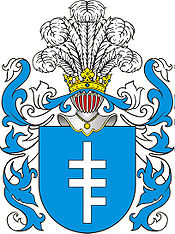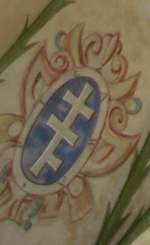- Piława coat of arms
-
Piława 
Battle cry: PiławaDetails Alternative names Piława, Strzała Earliest mention 1385 Towns Baltiysk, former town of Pilawa, Buczacz Families 92 names altogether: Balcer, Batulewicz, Bogdaszewski, Boleścic, Borowski, Bóbr, Buczacki, Buczacki Tworowski, Buterlewicz, Bystrzykowski, Charewicz, Charkowski, Chechelski, Chrzczonowski, Cieszkowski, Denewski, Dmitrowski, Drozdowski, Dulowski, Felsztyn, Ilkusz, Janowski, Jerzewski, Jurkowicki, Jurkowicz, Jurkowiecki, Jurkowski, Kamieniec, Kamieniecki, Kamieński, Kaminiec, Kliczkowski, Klikowicz, Knoth, Kubiatowski, Lachowski, Lalowski, Lechiński, Lechowski, Lichiński, Lichnowski, Lutostański, Łabuszewski, Łachowski, Mars, Masłowski, Miłkowski, Misiowski, Modzelewski, Monasterski, Moskorzewski, Murca, Mysiowski, Myślikowski, Nagórski, Namieniecki, Niewodowski, Okieński, Okiński, Petrowicki, Pęczalski, Pęczelski, Piec, Piecewski, Piecowski, Pieczyski, Pierzyński, Pilawski, Piotrkowczyc, Piotrowicki, Płatuść, Podgajewski, Podgórski, Potocki (and changed surnames like Petecki), Przełubski, Przyłubski, Rawa, Rawski, Rynkowski, Skałowski, Słostowski, Smalawski, Stanisławski, Sychowski, Szewiga, Szychowski, Światły, Twarowski, Tworkowski, Wierzychowski, Wojsik, Wojsz, Wójszyk, Zagórski, Zakliczewski, Żarski, Żelisławski, Żyrosław Piława (Polish pronunciation: [piˈwava]) is a Polish coat of arms. It was used by several szlachta (noble) families under the Kingdom of Poland and the Polish-Lithuanian Commonwealth.
Contents
History
The progenitor of the Piława Clan was supposed to have been Żyrosław z Potoka, who was fighting the Prussians, a pagan tribe and brought himself glory in the Battle of Pilawa, where he fought along Bolesław IV the Curly. The legend states that Żyrosław reached the pagan chief, fought him in hand-to-hand combat and killed him. The terrified enemy hordes fled the battle field. The related legend tells also that in 1166, to commemorate the victory, Bolesław IV bestowed a coat of arms upon Żyrosław, naming it for the place, where the battle took place.
Blazon
The Piława coat of arms assumed its final form in the late 14th century. Formerly, there were two differing patterns, and the records from the years 1387, 1388 and 1389 mention that it had to be a letter "Z" with two and a half of a cross, or an arrow with two and a half of a cross.
Notable bearers
Notable bearers of this coat of arms have included:
- Mikołaj Kamieniecki
- Antanas Kapłon
- Mikołaj Potocki
- Jan Potocki
- Antoni Protazy Potocki
- Roman Ignacy Potocki
- Stanisław "Rewera" Potocki
- Józef Potocki
- Andrzej Potocki
- Feliks Kazimierz Potocki
- Katarzyna Potocka
- Alfred Józef Potocki
- Alfred Wojciech Potocki
- Roman Potocki
- Stanisław Kostka Potocki
- Józef Potocki (XVII-1723)
- Franciszek Salezy Potocki
- Stanisław Szczęsny Potocki
- Teodor Andrzej Potocki
- Wiktoria Elżbieta Potocka
Family name changings during the Second World War and 1944-1953
The communist government of Poland was in deep opposition to every rich (specially noble) family. Hundreds of Potockis were killed by NKVD and Red Army. Many Potockis, who decided to stay in Poland were forced to change their family names (otherwise they could be killed, inprisoned or have other problems).
The most popular changes was from Potocki to Nowak, Kowalski, Gnejowicz, Stanisławski, Pryszkiewicz, Wszelaki, Petecki, Blacha, Musiał, Woldan, Walera, Melka, Madej and Pastuch.
See also
Categories:- Polish coats of arms
Wikimedia Foundation. 2010.

